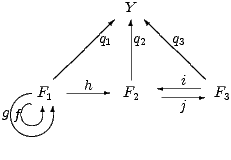
A Limit- Form for the diagram D is an
optimal12
Form for the diagram D is an
optimal12
- The optimality is expressed in the universality property for Limits.
|
solution of this equation system. One such optimal solution
L is explicitly given as
follows:

where the maps
p1,
p2 and
p3 are the natural projections from the cartesian product
FS(F123) = A1 × A2 × A3 to its three factors.
In our heuristic we associate the dual construction of a Colimit- Form for a
diagram like D with the activity of an idealized modelist. His main activity
consists in gluing objects. He may do so on the denotator-level as well as on the
formal level. The global object obtained from the four Euler-Tone-Net-Maps
(cf. section 1) is a typical example for such an activity on the denotator
level.13
Form for a
diagram like D with the activity of an idealized modelist. His main activity
consists in gluing objects. He may do so on the denotator-level as well as on the
formal level. The global object obtained from the four Euler-Tone-Net-Maps
(cf. section 1) is a typical example for such an activity on the denotator
level.13
- this is actually a Colimit-construction cf. [9], chapter 13.
|
Another type of gluing things is classification. This is what happens in a
Colimit- Form construction. Our idealized modelist starts by studying the
Coproduct
Form construction. Our idealized modelist starts by studying the
Coproduct

Its
FrameSet is the disjoint union

In his further activity he aquires the ability to identify those F123- denotators with each
other that are connected by one of the set-maps in the diagram D. He thus turns the
predicate P into a system of equations for
denotators with each
other that are connected by one of the set-maps in the diagram D. He thus turns the
predicate P into a system of equations for  Forms
Forms

The variable  Form Y of this system of equations involves three variable set-maps
qi : Ai
Form Y of this system of equations involves three variable set-maps
qi : Ai  FS(Y ) i = 1,2,3 from the AmbientSets of F1, F2 and F3 into the FrameSet
FS(Y ) of Y and the equations read as follows:
FS(Y ) i = 1,2,3 from the AmbientSets of F1, F2 and F3 into the FrameSet
FS(Y ) of Y and the equations read as follows:

A Colimit- Form for the diagram D is an optimal solution for this system of equations.
One such optimal solution C is explicitly given in terms of the FrameSet
Form for the diagram D is an optimal solution for this system of equations.
One such optimal solution C is explicitly given in terms of the FrameSet







